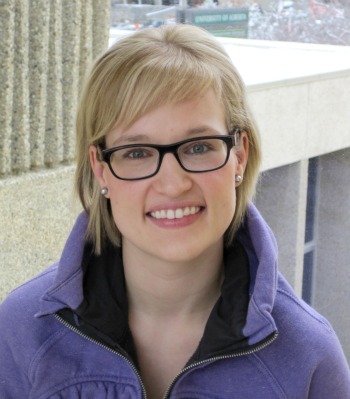
"When the students share a lived experience and meet a real person with a disability, they see the person first," says Dr. Joanna Clair.
It's not unusual for students to send Dr. Joanna Clair photos of washroom signs.
But this isn't for an unusual art project with a biffy theme: it's a lesson in awareness and building better understanding of the language and symbols associated with disability and how those enhance or detract from our perceptions, attitudes and assumptions about people who experience disabilities.
It's all part of Clair's PERLS 207 class that explores physical activity and recreation for special populations, and one of the challenges is to open students' eyes to prejudice and stimulate new ways of thinking about disability. "A great learning moment in the class is when we look at language and disability," she says. "For example, we look at the symbols on accessible washrooms and the words these symbols evoke. Students often say 'weak, old, inactive, frail, and needy.' But if you change the image by putting the arm back as though the person were pushing off, or draw speed lines behind the wheels the image becomes strong and athletic with just two changes."
Because Clair believes that experience is the best teacher, students have opportunities to learn from, and interact with individuals with a variety of disabilities, including those who have a spinal cord injury, stroke, muscular dystrophy, hearing impairment, or double limb amputation. "When the students share a lived experience and meet a real person with a disability, they see the person first," says Clair.
In another instance, Clair invited the Speaking of Schizophrenia Players to perform their play "Schizarella" (a take on the classic Cinderella tale except that Cinderella has schizophrenia) after a class that dealt with mental health issues. Afterwards the actors, all of whom either have schizophrenia or family members with the condition, answered students' questions.
"I invariably get students saying how much the course has changed the way they think about disability," she says.
Clair, who recently received a lectureship in the Faculty to teach courses in adapted physical activity, will, in addition to the second year course, teach three senior level courses: one on assessment and service delivery for special populations (PERLS 370), one on physical activity for older adults (PEDS 385), and another on active living for individuals with developmental disabilities (PEDS 471).
"My intent is to dispel myths," Clair says, adding that she's a firm believer in community service learning. To that end she's developed strong ties to community associations so the students' learning is peppered with experiences of working alongside people with disabilities. "When students have an experience working with a person with Down Syndrome, autism, or cerebral palsy, they can understand so much better, and it gives them that all-important one-on-one contact, opening them up to a new experience and view of people with disabilities."
Clair's own interest in the adapted field started in her undergraduate degree in kinesiology and her path to graduate school started with a a 'light-bulb' moment in a neuroscience class with Dr. Dave Collins (who was later to become her supervisor for her doctoral degree).
"We were talking about central pattern generators - patterns of neurons in the spinal cord - and looking at their function related to walking," remembers Clair, whose love of human science and physical education led her to a kinesiology degree. "I became fascinated with walking and how I could help people walk."
After completing her undergraduate degree, Clair began graduate studies with Collins, and was fast-tracked to a PhD, funded with a grant from the Natural Sciences and Engineering Research Council of Canada. For her thesis she looked at how to improve electrical stimulation protocols for individuals with muscle paralysis.
"In the community many people use electrical stimulation to help them walk, for example, pick up their foot at a certain point in their gait cycle, or flex their fingers to grasp an object," explains Clair. "We were looking at ways to apply the electrical stimulation on the surface of the skin to the paralysed muscles, and improve the stimulation protocols to make the muscle contractions larger and less fatigable, so the contractions last as long as they're required (to perform an action.)"
Clair says this understanding of the neurophysiology of disability has been an advantage to the classes she teaches and she's broadened her own learning into the sociology and psychology of adapted physical activity. She'll be playing a role in the development of courses in the adapted field - and is looking forward to it.
At heart, says Clair, it's the rewards of teaching that drive her. "I love the classroom. I like it because it's tangible; because you can often get an immediate sense of engagement, excitement, interest - or disinterest - from the students. Most of all I want to create a learning environment that inspires them."